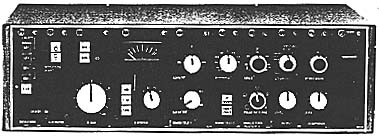Keith, the trepanned Soundfield you show is a Mk2. I believe only 1 exists and is in the estate of the late Prof. Peter Fellgett.
The Mk1 was done with 4 goosenecks and Calrec CM1050 cardioid stick mikes.
The Control Box is for a Mk3 (or probably a Mk3A), the first commercial version and the first I was involved with.
Mk3s, 3As & Mk4s are of course the Holy Hand Grenades of Ambisonia (with apologies to Monty P). No others have this Sacred status.
There is a 'feature' in the present software that requires afficionados to face North to reset CF. I've suggested to the developer, that while he sorts this out, he incorporates an option to face Mecca for those of the Muslim faith.
The thread is on the Sursound forum.
__________________
Keith, have you really got 2 'real' U47's that you believe have the vintage magic? Are they matched?
I've never had my paws on one.
I know vintage C12s sound very close to at least one modern version of the 414.
When the 'new' transistorized 414 came out, the BBC asked us to measure them cos some of their engineers thought the C12 sounded better. I turned it into a 'measure every mike in sight' exercise and begged & borrowed loadsa mikes. No U47. I think the Neumann I looked at was the stereo SM69 & maybe a U67 or U87. Circa 1980 so my memory is hazy.
The Mk1 was done with 4 goosenecks and Calrec CM1050 cardioid stick mikes.
The Control Box is for a Mk3 (or probably a Mk3A), the first commercial version and the first I was involved with.
Mk3s, 3As & Mk4s are of course the Holy Hand Grenades of Ambisonia (with apologies to Monty P). No others have this Sacred status.
Current experiments involve an Android phone taped to your headphones.Yes, binaural playback eliminates a major variable. Perhaps at some point an accelerometer on the listeners head could tweak for and simulate expected combing changes from head movement, while that would probably be weird too.
There is a 'feature' in the present software that requires afficionados to face North to reset CF. I've suggested to the developer, that while he sorts this out, he incorporates an option to face Mecca for those of the Muslim faith.
The thread is on the Sursound forum.
__________________
Keith, have you really got 2 'real' U47's that you believe have the vintage magic? Are they matched?
I've never had my paws on one.
I know vintage C12s sound very close to at least one modern version of the 414.
When the 'new' transistorized 414 came out, the BBC asked us to measure them cos some of their engineers thought the C12 sounded better. I turned it into a 'measure every mike in sight' exercise and begged & borrowed loadsa mikes. No U47. I think the Neumann I looked at was the stereo SM69 & maybe a U67 or U87. Circa 1980 so my memory is hazy.





